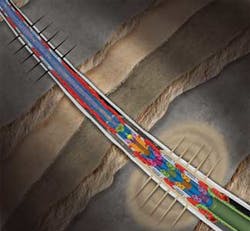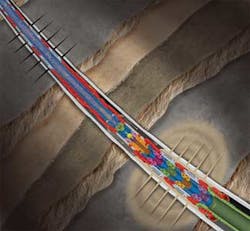Intelligent wells offer completion solution for Lower Tertiary fields
Savio Saldanha
Halliburton's Completion Tools
This summer will mark 15 years since the industry's first intelligent well installation. What started as a small niche in the completions segment has expanded to now offer solutions for a range of applications, many of them in the highly challenging environments.
Remote-operated interval control valves (ICVs) and real-time data from permanent downhole gauges (PDGs) allow well performance to be optimized without intervention. Hydraulic and electrical control lines strapped to the production tubing permit the use of multiple ICVs and PDGs in the completion sting. These control lines operate and communicate with the ICVs and PDGs remotely from surface.
Direct Hydraulics using the N+1 methodology (with "N" being the number of dedicated open lines for each ICV and "1" being the common close line to all ICVs) is the widely used downhole control architecture. Today, a single well or an entire field's performance can be monitored in real time and controlled using intelligent well technology. As operators move into more complex and deeper water projects around the world, the benefits of intelligent wells are increasingly necessary to the oil and gas industry to economically produce reserves and maximize recovery.
Intelligent wells
A growing number of installations and diverse product offerings among service companies demonstrate the industry's acceptance and growing use of intelligent well technology. Operators who are well aware of the advantages of intelligent wells are looking for ways to better integrate the remote operating and monitoring capability into their more difficult subsea completions.
In the Gulf of Mexico (GoM), new well targets in excess of 30,000 ft (9,144 m), such as in the Lower Tertiary Wilcox formation, are creating new completions challenges for both operators and oilfield service companies alike. With planned multi-zone producers or injectors in some of these ultra-deep HP/HT environments, methods of effective zonal control, equipment reliability, and minimizing the number of trips in the well are at the forefront of completion design discussions. The desire for solutions that reduce rig operating and intervention costs in these tough environments presents new opportunities for efficient completions using intelligent tools.
For service companies, there are several technical hurdles to be overcome to achieve marketable solutions in these deeper subsea wells. Accommodating the required pressure and temperature ratings is a major challenge when bottomhole pressures are in excess of 20,000 psi and temperatures in some areas are over 400° F (204° C). Technical advances will need to be made concerning elastomers and metallurgy for tools to operate reliably in these demanding environments.
These new tool designs must still allow sufficient annular and tubing flow areas for high-rate pumping and production, have long-term service capability, and be compatible with standard equipment and tubular sizes. It will be a balancing act between cross-sectional tool geometries and material yield strength. Thinner cross-sectional parts would need to be made of high-yield strength material to combat the high bottomhole pressures.
Again these parts would need to be made of corrosion-resistant alloys (CRA) to combat the corrosion effects of the completion and produced fluids that will be used to complete these deep wells. Some CRA materials have a certain yield strength limit beyond which they tend to corrode.
Technology limits
Likewise conventional chevron-style dynamic seal stacks for downhole equipment such as ICVs are not suitable in these HP/HT environments. A combination of elastomers, thermoplastics and steel will be required for dynamic seal stacks to provide the resilience and rigidity required to withstand high pressure differential at temperature.
The Lower Tertiary rock formations encountered in the GoM tend to be comparatively high-pressure and high-temperature reservoirs, often with high sand content (+70%) and usually underlie a thick layer of salt sediments. The play is expected to feature long, continuous pay zones as long as 3,000 ft (914 m). High- rate fracture stimulation techniques along with screens will be the sand control method that will be widely employed. As a result, operators may have to adopt multi-zone, single-trip fracturing strategies.
The stimulation technologies employed would need to have the flexibility to address various interval lengths and at the same time provide effective zonal isolation in order to initiate effective frac stimulations. The system would need to handle proppant concentrations ranging from 1-12 ppg, proppant loading in excess of 500,000 lb per interval, and rates in excess of 50 bpm.
The system would need to provide a suitable barrier to prevent proppant flowback, be tolerant of formation compaction, and most of all be able to handle fluid loss or charged up zones while completing the intervals. Current single-trip multi-zone treatment methods such as Halliburton's Enhanced Single-Trip Multi-Zone (ESTMZ) system provide the consistency and reliability needed to develop similar tools with even higher pressure and temperature ratings.
Where flow control is concerned, currently available intelligent completion technology limits the completion of these lower tertiary wells to effectively two zones. A typical intelligent completion in the GoM involves installing ICVs in the upper completion. These ICVs are stacked one on top of the other with the lower shrouded ICV controlling the bottom zone. Zones with similar pressure regimes or those with similar injectivity indexes are comingled.
As discussed, sand control involving screens would be essential in almost all wells being completed in the lower tertiary. Placing the current ICVs inside the screen assembly severely restricts the flow rate involved in these highly prolific producers. Moreover, the OD of the tungsten carbide-lined deflector valves required in high-rate water injectors hampers installing these valves inside gravel pack screens.
Optimum performance
Monitoring the pay zone is essential for optimizing reservoir performance. Monitoring downhole activity can provide good information in and around the wellbore as well as across the reservoir. A detailed mapping of the hydrocarbon behavior can provide a meaningful indication of how the reservoir is overburdened under the influence of production and secondary recovery phases. Currently single point, quartz crystal pressure and temperature sensors are widely used to monitor these reservoirs.
Fiber-optic sensors provide a better resolution of the reservoir interval (1 m interval). However, interface issues downhole as well as at the subsea pod are a challenge to installing fiber optic in these subsea wells at the current point in time. The size of the gauge mandrels involved in deploying the quartz gauges requires installing the gauge assembly outside the gravel pack assembly, at times placing these gauges hundreds of feet away from the pay zone. Thus the pressure being monitored is not only measuring comingled pressure but is also not representative of the true pressure from each interval.
Discussions are under way between oil companies and service companies alike to bring the intelligent flow control and reservoir monitoring to the sandface. Innovative technology will be required not only to meet the HP/HT requirement of the lower tertiary, but also to maintain tool designs within the drilling and completions current space envelope (i.e., hole/casing sizes) and at the same time provide higher production or injection flow rates.
The ICVs, PDGs, and screen designs would need to be optimized to provide an integrated solution or a concentric intelligent completion solution. A reduction in screen internal diameter has a domino effect on the rating of the frac service tool. A reduction in the outer diameter of the service tool will permit faster erosion requiring an additional trip in hole with a new service tool. Moreover, the pressure drop created at 50-bpm flow rate in the service tool may be excessive and could be a limitation to the frac treating pressure. The number of control lines required for operating and communicating to the ICVs and PDGs would need to be minimized as these lines would either be installed on the screen outer diameter or installed on the concentric string.
Enabling technology
In either case the space envelope involved limits the applicability of the direct hydraulics N+1 downhole control system. Interfacing these control lines with the upper completion or production string may require an electro-hydraulic downhole wet connect. This key enabling technology is currently in the infancy stage.
Reliable mating and de-mating is essential to the success of these extremely expensive wells. Incorporating fiber-optic technology across the sandface level would require a fiber-optic disconnect tool. Various service companies are working to develop a solution that would bring the benefits of fiber technology in long horizontal dry tree applications to the subsea environment.
Again, all these solutions would need to consider future secondary recovery methods; such as electric submersible pumps from an up-hole interface standpoint.
Thus, several technical hurdles need to be overcome to provide a robust and reliable completion solution that will unlock the potential of the Lower Tertiary. Current technology would need to be re-engineered or optimized. Radical changes to the way we drill and complete these wells may be required to develop technology that would allow us to reach the goal without being cost prohibitive. Certain compromises will need to be made as the technology evolves. The oil companies and service companies will need to work together to develop the next generation technology to maximize the value offered by the Lower Tertiary.

